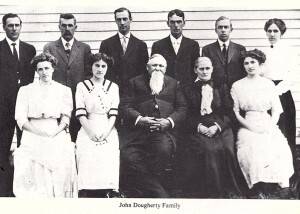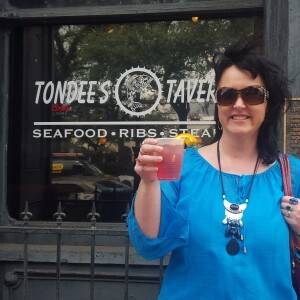Sample a Taste of Savannah with an Iowa-Irish Twist
guest blog post by Darcy Maulsby
 No one does St. Patrick’s Day like Savannah, Georgia—a pleasant discovery for an Iowa farm girl like me with proud Irish heritage and an insatiable appetite for America’s rich culinary heritage.
No one does St. Patrick’s Day like Savannah, Georgia—a pleasant discovery for an Iowa farm girl like me with proud Irish heritage and an insatiable appetite for America’s rich culinary heritage.
Maybe I inherited my love of good food from my great-great-grandfather, John Dougherty (the man with the impressive white mustache in the Dougherty family photo in this blog). An American success story, John was born in County Cork, Ireland, in 1848, came to America with his parents at age 10, grew up in New Jersey, worked in the rolling mills of Chicago and farmed in Illinois for 20 years. After he moved to Calhoun County, Iowa, in 1889, he purchased 200 acres and “placed the land under a high state of cultivation,” a legacy my family carries on today with our Century Farm.
With my Irish heritage, I felt right at home during a recent Iowa Farm Bureau trip to Savannah, which boasts the third largest St. Patrick’s Day Parade in the world. Oh sure, the city’s open container law that allows alcoholic beverage consumption on the street in the historic district also distinguishes the Hostess City, but Savannah’s diverse food scene is even more intriguing.
During the 3-hour First Squares Food Tour with Savannah Taste Experience Food Tours, our group tasted our way from restaurants on the riverfront (where the cobblestones in the streets once served as ship ballast) to pubs and bakeries near Savannah’s historic town squares. Along the way, we discovered the city’s surprising, savory culinary identity, which includes:
- Hearty Scottish food. Scottish cuisine? While Savannah has Irish pubs, one of the best meals I ate on my culinary tour included shepherd’s pie from Molly MacPherson’s Scottish Pub at 311 W. Congress Street. After James Oglethorpe of England established Savannah as the first permanent settlement in Georgia in 1733, he recruited Scots (who were among the finest soldiers in the world) to provide a buffer between the English colony and the Spanish in Florida. Georgia might have been a Spanish colony had it not been for these Scottish Highlanders, who sailed from the Old World to Savannah in 1735.
- She-crab soup to shrimp and grits. No trip to Savannah would be complete without a taste of the Lowcountry, which stretches from the Savannah River to the coastal area of South Carolina. As we sampled seafood chowder at Rocks on the River at 102 W. Bay Street, we learned about Savannah’s unique geography. The area’s rich estuary system provides an abundance of shrimp, fish, crabs and oysters that were not available to non-coastal regions of the South prior to refrigeration. Try the delicious she-crab soup in Savannah. Also, sample the shrimp and grits—a coastal classic—at historic Tondee’s Tavern at 7 East Bay Street.
 Chatham Artillery Punch. Speaking of Tondee’s Tavern, order a Chatham Artillery while you’re there. The brave patriots of the Chatham Artillery who fought in the Revolutionary War impressed George Washington so much that he presented the Chatham Artillery with cannons, including one captured at the Battle of Yorktown in 1781. These “Washington Guns” were fired to salute President James Monroe when he visited Savannah in May 1819. Occasions like this were undoubtedly celebrated with Chatham Artillery Punch. No one is sure how this heady concoction originated, but local lore says Savannah ladies made the first beverage. Then, one by one officers of the Artillery sneaked in and added rum, bourbon and more, creating Savannah’s most noted drink in two centuries.
Chatham Artillery Punch. Speaking of Tondee’s Tavern, order a Chatham Artillery while you’re there. The brave patriots of the Chatham Artillery who fought in the Revolutionary War impressed George Washington so much that he presented the Chatham Artillery with cannons, including one captured at the Battle of Yorktown in 1781. These “Washington Guns” were fired to salute President James Monroe when he visited Savannah in May 1819. Occasions like this were undoubtedly celebrated with Chatham Artillery Punch. No one is sure how this heady concoction originated, but local lore says Savannah ladies made the first beverage. Then, one by one officers of the Artillery sneaked in and added rum, bourbon and more, creating Savannah’s most noted drink in two centuries.
I might just mix up my own version of Chatham Artillery Punch while the green beer flows on St. Patrick’s Day. I’ll also be thinking of Savannah as I prepare my recipe for Beer-Braised Irish Stew and leave you with this Irish blessing: As you slide down the banisters of life, may the splinters never point the wrong way!
Darcy is a fifth-generation Calhoun County, Iowa, farmer, business owner, ag journalist, speaker, photographer and author of three books, including “A Culinary History of Iowa,” which is available at www.darcymaulsby.com.
Beer-Braised Irish Stew
Ingredients
1 tablespoon vegetable oil
1 (3 pound) beef chuck roast, trimmed of fat and cut into 1/2-inch cubes
2 tablespoons all-purpose flour
2 coarsely chopped onions
1 cup coarsely chopped carrots
2 potatoes, diced
2 ribs celery, chopped
1 (12 fluid ounce) can or bottle of beer (note: just about any beer will work, although a very dark beer like Guinness can impart a bitter taste)
2 cups beef broth
2 bay leaves
1 teaspoon dried thyme
1 teaspoon salt
1/2 teaspoon ground black pepper
2 cloves garlic, minced
2 tablespoons Worcestershire sauce
Peas, if desired
Instructions
Heat the vegetable oil in a large Dutch oven over medium-high heat until very hot. Brown the meat in 2 batches, stirring to brown the cubes on all sides. Return all the meat to the Dutch oven. Sprinkle meat with flour, and stir lightly to coat the meat with flour. Stir in onions, carrots, potatoes, celery, beer, beef broth, bay leaves, thyme, salt, pepper, garlic and Worcestershire sauce. Bring mixture to a boil; cover.
Place Dutch oven into preheated oven, and cook for 45 minutes. Uncover, stir the stew, and cook until the beef is very tender and the liquid is reduced by half, about 45 more minutes. Add peas, if desired, near the end of the cooking process. Remove bay leaves. Serve and enjoy!
